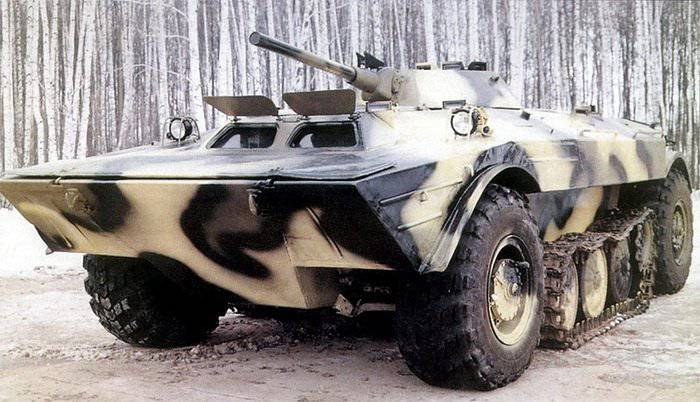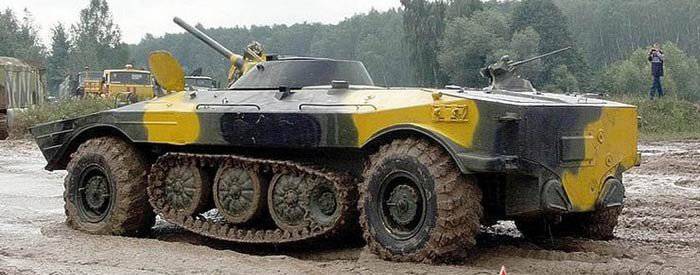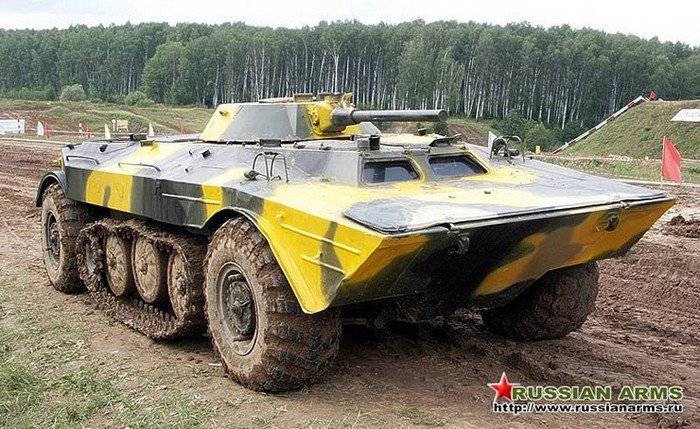Experienced BMP - "Object 19"
History appearance of the project
The requirements for the BMP were formed by the USSR Central Armored Directorate at the end of the 1950s. The army demanded from industry a machine for which it was planned to install a new weapon system created by the Instrument Design Bureau in the city of Tula. The basis of the new weapon system was a compact turret, which contained the 1 man. The main weapon of the new armored vehicle was to be the 73-mm gun 2А28 "Thunder", which has an automatic loader system. In the event of an automaton failure, the loading could be carried out completely in manual mode. This 73-mm gun was unique weapons. It fired 73-mm PG-9 and OG-15В grenades, which were similar to the LNG-9 Spear anti-tank grenade launchers, while the main difference was the power of the propellant charge.
At that time, other armies of the world tried to install various types of recoilless guns and grenade launchers on armored vehicles, but could not mount them in the turret because of the backward-directed jet at the time of the shot. In the new turret, the Grom gun was supplemented with the 7,62-mm PKT machine gun coaxial with it. To fight the enemy tanks at distances of more than 700 meters it was planned to use ATGMs. A simple rail launcher for the new Malyutka anti-tank missiles (according to the NATO codification Sagger) was mounted above the gun barrel. This combination of weapons and firepower was unprecedented for such compact and small combat vehicles. The frontal armor of the BMP was supposed to protect the crew from 20-mm NATO ammunition.

Work on the implementation of the task of the USSR Ministry of Defense began at a number of enterprises in the country at the beginning of the 1960s. Among the main requirements for a new type of armored vehicles for motorized rifle troops, the military singled out:
1. Significant firepower of the machine;
2. Protection of the crew and assault forces against weapons of mass destruction;
3. The possibility of self-combat with enemy armored vehicles;
4. Overcoming water obstacles.
Although the set of weapons used was chosen in advance, the military did not take decisions regarding the scheme of the BMP itself. At that time, the Soviet Army was still quite wary of the concept of a fully tracked combat vehicle due to its high price. Many infantry officers believed that the maintenance of a fairly complex tracked vehicle would be higher than the capabilities of soldiers serving in conscript service. As a result, the GBTU decided to create a BMP on the basis of competition between several design bureaus and consider a variety of design schemes for the combat vehicle. The design bureaus that participated in the competition included the design bureau from Volgograd, which later became famous due to the development of the BMD-1 machine, as well as the Isakov Design Bureau, a relatively new design bureau, which was formed by a group of designers of heavy tanks in Chelyabinsk, as well as small groups designers from engineering enterprises of Bryansk and Rubtsovsk.
One of the developments that were presented to the military was the "19 Object". At the same time the military had plenty to choose from. So the Bryansk project - “The 1200 Object” was the vehicle of the wheel layout, which was based on the rich experience of the Bryants in creating heavy trucks, such as the BAZ-543 family of cars. Against this background, the Rubtsovsk "Object-19" was the most unusual project, which had a wheeled-tracked undercarriage, which resembled the pre-war Austrian "Sauers". The “19 Object” had a conventional wheel suspension for driving on roads and tracks, which were located in the middle of the hull and could be used to improve the quality of terrain. The BMP engine was in the stern, the infantry had to leave the car through hatches located on the roof of the rear of the tower. The design office of Gavrilov presented the project 2 for the competition - an object 914 and 911. The 911 project was a bit unusual. He had 4 retractable wheels under the hull, which could be lowered on the road to give the car extra acceleration.

At the same time, the 914 object was a more classic and fully tracked variant, with the engine located in the stern, the crew left the car through the roof. The last project was the 765 Isakov object, which was also completely tracked. It was the “765 Object” that was preferred by the military, and it went down in history as the BMP-1. The main difference between the “765 Object”, which was called “Kite”, and the rest of the machines was the location of the engine in front of the hull. Such an arrangement made it possible to place in the stern a branch of the assault force and a door for conveniently leaving the combat vehicle. Such an arrangement later became “classic”.
Description of the “19 Object”
The project of a rather unusual wheeled-tracked infantry fighting vehicle on a very original chassis was presented by the design bureau of the Altai Tractor Plant in the 1964 year. The machine, which was named "Object 19", had a welded body of rolled armor plates and had some similarities with the BRDM-2. The design of its chassis was a wheeled chassis (with the formula 4X4), as well as an auxiliary track drive, which was located between the axles of the front and rear wheels. Tracked propulsion was planned to be used only to increase the terrain, for which he could fall to the ground. At the same time, the transition from a wheel run to a wheel-track could be carried out right on the spot or in motion in just 15-20 seconds. In the BMP chassis, special hollow rollers were used, borrowed from the PT-76 lightweight amphibious tank.
According to the layout scheme used, the driver’s mechanic’s seat was located on the front left, the commander’s seat was to the right of the driver. Each crew member had his own separate hatch to leave the BMP. In the middle of the corps there was a fighting compartment with a rotating turret. Places paratroopers located around the fighting compartment. They had to leave the combat vehicle through the rear hatches mounted on the roof of the hull.

The 73-mm 2А28 “Thunder” 7,62-mm smooth-bore cannon, a 9-mm machine gun and a launcher for the Malyutka anti-tank missiles 14-mm were mounted in the single-seat turret. In the stern of the BMP "Object 19" was the engine compartment, in which the water cooling engine was installed, which developed power in the 300 HP. The “19 object” could move afloat with the help of 2's jet propulsion (water cannons) of the jet type, the same principle was used on the BMP-1.
Tactical and technical characteristics of the BMP "Object 19":
Combat weight of the machine –13,1 t.
Dimensions: length - 6830 mm., Width - 2870 mm., Height - 2100 mm.
Overcoming obstacles: rises to 25 degrees, roll - 25 degrees
Power unit - 300 HP
Maximum speed - 80 km / h, afloat - 10 km / h.
Power reserve - 500 km.
Car booking was bulletproof
Crew - 2 man, landing - 8 man
Armament: 73-mm gun 2А28 (40 shells), 1х7,62-mm PKT machine gun (portable ammunition 2000 cartridges), 4 PTO 9М14М "Malyutka". The machine used the 1PN22 sight and the P-123 radio station.
Information sources:
-http: //otvaga.narod.ru/Otvaga/armour-rus-obj/a_019.htm
-http: //vooruzenie.ru/publ/5-1-0-20
-http: //ru.wikipedia.org
Information